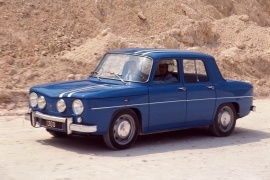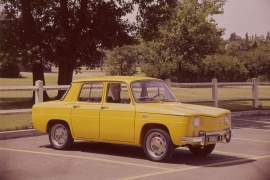RENAULT 8 Models/Series Timeline, Specifications & Photos
First production year: 1962
Engines: Gasoline
Back in the '60s, the best advertising was the race-arena: especially the rally-scene. Renault understood that and desperately tried to make a car fit for the famous competition. That's how the R8 Gordini was born.
It was based on the regular Renault 8 Major, an upgraded version of the Renault 8. Renault hired the former race-driver and engineer Amedee Gordini, nicknamed "the sorcerer." Gordini took the basic 1.1-liter engine and tuned-it to develop 89 hp, which was almost twice as much as the standard R8 Major's 50 hp. It was the first try, and Renault unveiled it in 1964. But Gordini was not satisfied. It was just a small adjustment for him.
With the car ready to race, Renault lined up six vehicles in the 1964 Tour de Corse. They raced against strong competitors such as the Alfa Romeo Giulia TZ, Lancia Flavia, Ford Falcon, and Porsche 904 Carrera GTS. Renault 8 Gordini took four out of five top positions, including first place.
Two years later, in 1966, the true R8 Gordini saw the light of day. The entire vehicle was redesigned as a race-car under the otherwise bland bodywork of an R8. Renault installed four headlights on the 1966 model to resemble the "Cibie lights" from the rally version, and it launched the car with a specific "blue ciel" color with two white stripes that crossed the vehicle from front to the engine bay, which was in the rear. Unlike the '64 version, it featured a 5-speed manual gearbox. The engine was enlarged to a 1.25-liter displacement, and in the street version, it offered 100 hp.
Renault sold the vehicles to the public and started a one-make race championship. The rally version of the R8 Gordini offered 115 hp.
The French automaker introduced the model 8 as a successor for the Dauphine lineup in 1962, and it was an advanced vehicle for its times, although it didn't shined in the power department.
The 8 looked like a stack of boxes. Its sharp lines and flat panels were a complete departure from the rounded shapes of its predecessors. Yet, the design team couldn't completely understand the new trends, so they penned the car with simple lines. At the front, the carmaker installed a pair of round headlights, and there was no grille between them since the engine was in the back. Later on, the Gordini version received an additional set of smaller lamps. Thanks to its four doors, the 8 could transport four people inside. Both the windshield and the rear windscreen were very steep since the carmaker tried to keep an overall short length but still offer a tall-enough greenhouse for adults.
Inside, Renault installed a pair of seats at the front and a narrow bench at the rear. The dashboard was more of a flat metallic panel with a few dials and gauges. Only the front windows were cranked, while the rear ones sported a sliding system, which was not very appreciated and tended to get stuck. Since the engine was in the rear, the trunk was in the front.
Renault offered the 8 with a choice of few gasoline engines. Most of them featured either a 1.0 or a 1.1-liter displacement. Later on, in 1964, the carmaker introduced the Gordini version that was powered by a 90 hp (89 PS) inline four, paired with a five-speed manual. Just like its predecessor, the 8 sat on top of a platform that provided independent suspension and disc brakes in all corners.

